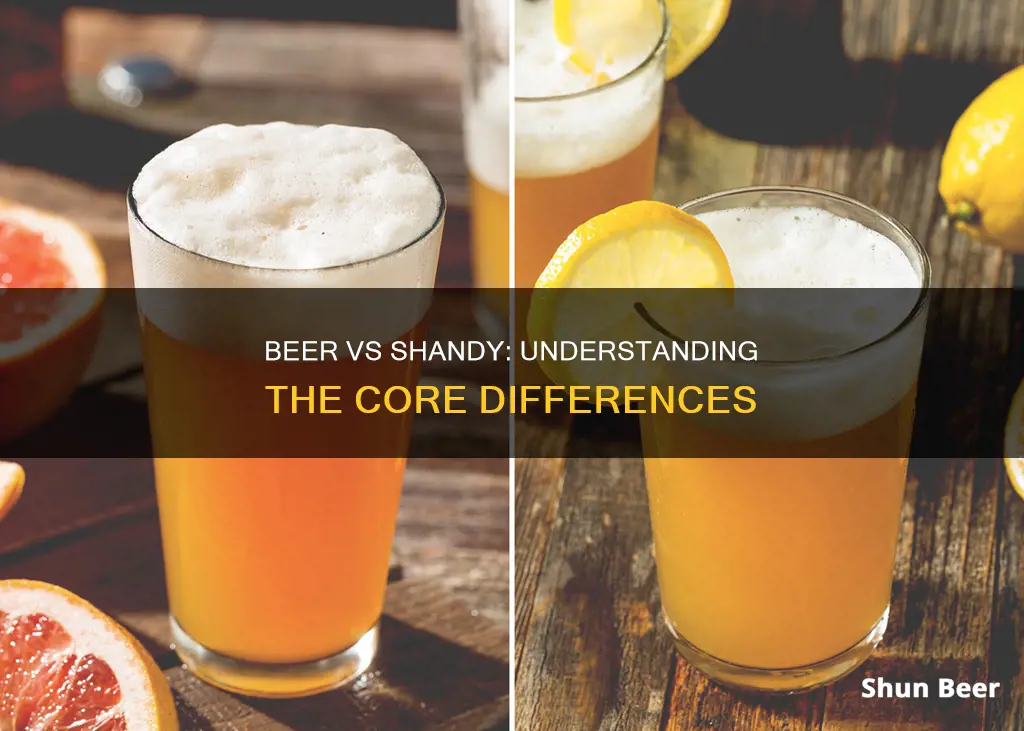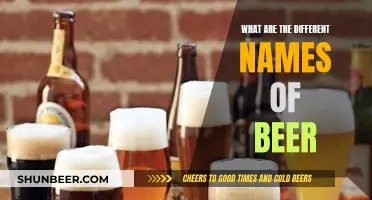
A shandy is a beer cocktail, usually made with equal parts beer and a lemon-flavoured beverage, often lemonade or lemon-lime soda. The drink is popular in Europe, Australia, New Zealand, South Africa, and Canada, and is especially refreshing during the summer months due to its low alcohol content. The term 'shandy' is believed to have originated in Britain in the 1850s as a shortened version of 'shandygaff', which refers to a mixture of beer and ginger beer or ginger ale. Over time, the ginger ale in the shandygaff was replaced by lemonade or lemon soda, resulting in the modern-day shandy.
What You'll Learn

A shandy is a beer cocktail
The name 'shandy' is a shortened version of the older British name 'shandygaff', which was first recorded in 1853 and refers to a beer mixed with ginger beer or ginger ale. By the late 19th century, the ginger ale in the shandygaff was replaced by lemonade or lemon soda, and the drink became known simply as a 'shandy'.
A traditional British shandy is made with a blond lager (usually Pils or Helles) and a lemon-lime soda such as 7UP, mixed in a 50/50 ratio. However, the drink can be customised with different types of beer and soda, and the proportions can be adjusted to suit individual taste. For example, some people prefer a little more beer, while others prefer a little more soda.
In the United States, a shandy is sometimes made with beer and the US-style lemonade made from lemon, sugar, and water. This is not the traditional way to make a shandy, but it is a variation that some people enjoy.
In Germany, a similar drink called a 'radler' is made with beer and any form of fruit juice, including grapefruit juice. The name 'radler' means 'cyclist' in German and is said to originate from a story about a Bavarian innkeeper who mixed beer with citrus juice to serve to a group of thirsty cyclists.
Exploring the Vast World of Beer: A Guide to Brands
You may want to see also

It's made with 50% beer and 50% lemonade/citrus soda
A shandy is a beer cocktail, usually made with equal parts beer and lemonade or citrusy lemon-lime soda. This means it's made with 50% beer and 50% lemonade or citrus soda. The ratio can be tinkered with to suit your taste, of course, with a little more beer or a little more lemonade or soda.
A traditional British shandy is a mixture of beer and lemon soda, most commonly in a 50/50 ratio. In the UK, lemon-lime soda (like 7UP) is referred to as "lemonade", which can be confusing for those outside the UK. In the US, for example, "lemonade" usually refers to a drink made with lemon, sugar, and water.
In the US, a shandy is often made with a blond lager (usually Pils or Helles) as a base, mixed with lemonade or lemon-lime soda. In Britain, a shandy was originally known as a "shandygaff", made with beer and ginger ale or ginger beer. Over time, the ""gaff" was dropped, and the ginger ale was replaced by lemonade or lemon soda.
Exploring Samuel Adams' Diverse Beer Flavors
You may want to see also

It originated in Britain in the 1850s
A shandy is a beer cocktail, usually made with equal parts beer and a lemon-flavoured beverage, such as lemonade or lemon-lime soda. It is popular in the summer months due to its low alcohol content and refreshing taste.
The term 'shandy' is a shortened version of 'shandygaff', which was first mentioned in Britain in the 1850s. The earliest written record of the word dates to 1853, when it appeared in Cuthbert M. Bede's comic novel, 'The Adventures of Mr Verdant Green'. In the novel, Mr Green states that a friend taught him "to make shandy-gaff and sherry-cobbler …: oh, it's capital!". Shandygaff is a compound word, but the origin of the term is obscure. One theory suggests that 'gaff' is a portmanteau of 'ginger' and 'half', as the original shandygaff was made with beer and ginger ale or ginger beer. By the late 19th century, shandygaff had been shortened to shandy, and creative drinkers began to experiment with other mixers, such as lemonade, orange juice and grapefruit juice.
In Britain, a shandy is usually ordered as either a "bitter shandy" (50/50 bitter beer and fizzy lemonade) or a "lager shandy", where lager is substituted for the ale. In England, Wales and Scotland, a "lager top" is a lager with a small amount of lemonade on top, which reduces the lager's bitterness.
The shandy is similar to the Radler, a German beer cocktail that also features a 50/50 mix of beer and a citrusy soft drink. The Radler was invented in Bavaria in 1922, almost 70 years after the shandy.
Hard Cider vs Beer: What's the Difference?
You may want to see also

It's called a 'radler' in Germany
A shandy is a beer cocktail made using equal parts beer and a lemon-flavoured beverage, usually lemonade. It is a popular drink in the UK, Europe, Australia, New Zealand, South Africa, and Canada.
In Germany, a similar drink is called a radler, which is German for 'cyclist'. The radler is said to have been invented in the 1920s by an innkeeper named Franz Xaver Kugler, who ran a beer garden in Deisenhofen, a small town near Munich. The story goes that a large group of cyclists stopped by his inn one hot summer day, and Kugler, running low on beer, mixed it with citrus juice or lemonade to stretch his supply. The resulting concoction was a hit, and the name 'radler' was born.
The main difference between a shandy and a radler is that while a shandy is typically mixed with lemonade or lemon-lime soda, a radler can be mixed with any form of fruit juice, including grapefruit or orange juice. Additionally, the shandy originated in England in the 1850s, while the radler was invented in Bavaria about 70 years later.
Both drinks are refreshing options for hot summer days and are easy to make at home. They are also lower in alcohol content than a typical beer, making them a good choice for those looking to consume less alcohol.
Moretti vs Peroni: What's the Difference?
You may want to see also

It's a popular summer drink
Shandies are a popular summer drink due to their refreshing taste and low alcohol content. Shandies are made by mixing beer with a lemon-flavoured beverage, usually lemonade, resulting in a drink that is lighter in alcohol and perfect for hot summer days. The drink's low alcohol content also means that shandies are often exempt from laws governing the sale of alcoholic beverages.
The drink's refreshing nature is further enhanced by the use of chilled or ice-cold ingredients. The beer used can be any variety of the drinker's choice, such as a pale ale, pilsner, or lager, and the lemonade can be store-bought or homemade. The addition of sparkling water or tonic can also add a refreshing twist to the traditional shandy.
The origin of the shandy can be traced back to 1853 in Britain, where it was known as a "shandygaff" and was made with beer and ginger beer or ginger ale. Over time, the drink evolved, and by the late 19th century, the shandygaff had transformed into the shandy we know today, with lemonade or lemon soda replacing the ginger ale.
Today, shandies are popular not only in the UK but also in Europe, Australia, New Zealand, South Africa, and Canada. They are particularly well-suited to hot and humid climates, providing a refreshing and hydrating drinking option during the summer months.
Explore the Diverse World of Beer Styles
You may want to see also
Frequently asked questions
A shandy is a beer cocktail made by mixing beer with a lemon-flavoured beverage, often lemonade, or lemon-lime soda. It usually has a lower ABV due to its composition, which is typically half lemonade and half beer.
A shandy is a cocktail made with beer and a lemon-flavoured beverage, whereas a beer is not mixed with any other beverage. Shandies are also lower in ABV, making them more hydrating in warm weather.
A shandy is typically made with lemonade or lemon-lime soda, whereas a radler can be mixed with any form of fruit juice, including grapefruit juice. The shandy originated in Britain in the 1850s, while the radler was invented in Bavaria about 70 years later.







